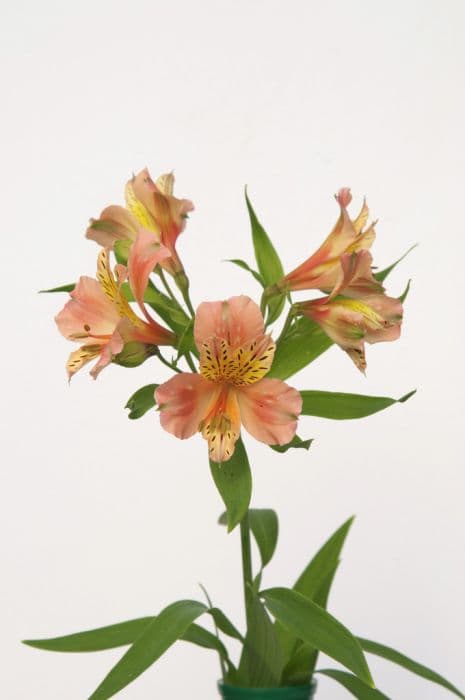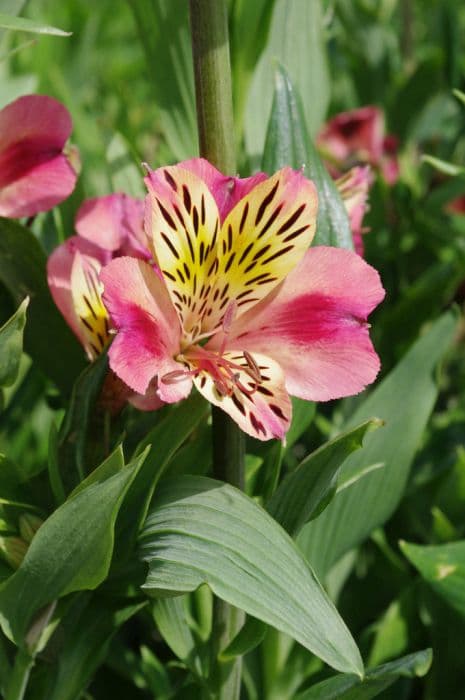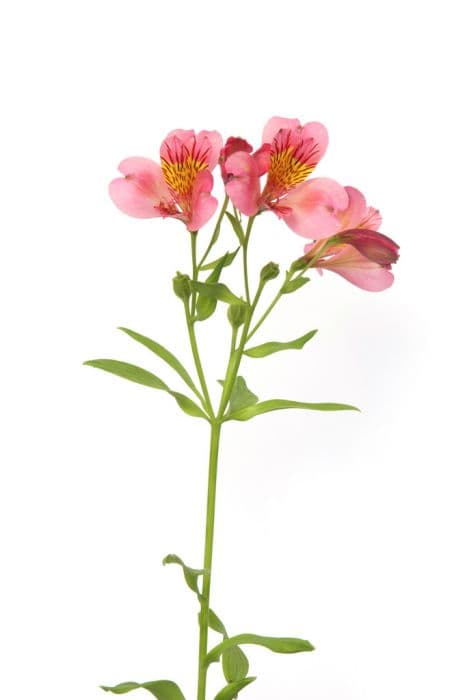Peruvian Lily Alstroemeria 'Solent Crest'

ABOUT
Alstroemeria 'Solent Crest', commonly known as the Peruvian Lily or Lily of the Incas, is a striking flowering perennial known for its showy blooms and lush foliage. The plant produces an abundance of flowers, each with a unique and intricate pattern. The petals exhibit a blend of colors, typically featuring shades of yellow and cream with streaks or speckled markings in a pink or light red hue. The throat of each flower often displays a contrasting color with darker flecking and streaks, which adds to the visual interest and complexity of the blossoms. Flower clusters emerge from the top of long, slender stems, which are surrounded by lance-shaped, green leaves with a slight twist, giving the plant a dense and robust appearance. The leaves have a glossy texture and create a lush backdrop for the bright and colorful flowers. The Peruvian Lily is admired for its long-lasting flowers, which make excellent cut flowers for arrangements, adding elegance and exotic charm to any floral display.
About this plant
 Names
NamesSynonyms
Peruvian Lily, Lily of the Incas, Parrot Lily
Common names
Alstroemeria 'Solent Crest'
 Toxicity
ToxicityTo humans
The Peruvian Lily, which is a common name for Alstroemeria, has low toxicity to humans. However, ingestion can lead to minor symptoms such as nausea, vomiting, or diarrhea. Handling the plant may sometimes cause skin irritation due to the presence of tulipalin, a compound also found in tulips. It is advisable to exercise caution and avoid ingesting parts of the plant or contacting the sap if you have sensitive skin.
To pets
The Peruvian Lily is considered non-toxic to cats and dogs. However, like many plants, it may cause mild gastrointestinal upset if ingested in large quantities. Symptoms could include vomiting or diarrhea, but significant toxicity is unlikely. Nonetheless, it is generally a good practice to discourage pets from eating ornamental plants to avoid any potential health issues.
 Characteristics
CharacteristicsLife cycle
Perennials
Foliage type
Evergreen
Color of leaves
Green
Flower color
Mixed
Height
2-3 feet (0.6-0.9 meters)
Spread
1-2 feet (0.3-0.6 meters)
Plant type
Bulb
Hardiness zones
7-10
Native area
South America
Benefits
 General Benefits
General Benefits- Long-Lasting Blooms: Alstroemeria, commonly known as Peruvian Lily, is prized for its long flowering period that can add color to gardens or bouquets for several weeks.
- Variety of Colors: Peruvian Lilies come in a wide range of colors and patterns, which makes them versatile for various garden designs and floral arrangements.
- Attracts Pollinators: These flowers can attract bees, butterflies, and other pollinators to your garden, aiding in the pollination process for a healthy and vibrant ecosystem.
- Low Maintenance: Peruvian Lilies are known for being relatively low-maintenance, requiring minimal care once established, making them suitable for busy gardeners.
- Drought Tolerance: They are somewhat drought-tolerant, meaning they can survive in drier conditions once they're established, making them suitable for water-conscious landscaping.
- Cut Flower Quality: Alstroemeria 'Solent Crest' is excellent for cutting with a long vase life, making them great for floral arrangements and home decoration.
- Easy to Grow: This plant is generally easy to cultivate both in the ground and in containers, which makes it accessible for gardeners of all skill levels.
 Medical Properties
Medical PropertiesThis plant is not used for medical purposes.
 Air-purifying Qualities
Air-purifying QualitiesThis plant is not specifically known for air purifying qualities.
 Other Uses
Other Uses- Photography Backgrounds: The striking blooms of the Peruvian lily can be used as an alluring background for close-up photography work, providing a vibrant and colorful setting.
- Educational Material: Botany and horticulture programs may use the Peruvian lily to educate students on plant genetics, due to its complex hybrid nature and variability.
- Floral Art Supplies: The colorful petals of the Peruvian lily can be pressed and used in creating floral art or crafts, such as handmade greeting cards or bookmarks.
- Costume Embellishments: Individual flowers or petals of the Peruvian lily can be used to adorn costumes for theatrical productions or festive carnivals.
- Table Centerpiece: With its captivating beauty and long vase life, the Peruvian lily serves well as a living table centerpiece for events and gatherings.
- Culinary Garnish: Though not commonly consumed, the vibrant blooms can be used to garnish plates or drinks for an exotic touch in high-end culinary presentations.
- Color Dye Source: The pigments from the Peruvian lily petals may be used as a natural dye source for fabrics or artisanal crafts.
- Perfume Inspiration: The subtle fragrance of the Peruvian lily can inspire perfume and scent makers in their formulation of floral fragrances.
- Ice Cubes Decoration: By freezing the petals of the Peruvian lily in ice cubes, one can create visually stunning ice for use in decorative punch bowls or cocktails.
- Plant Breeding: Horticulturists might use the Peruvian lily in plant breeding programs to develop new cultivars with desired floral characteristics and performance traits.
Interesting Facts
 Feng Shui
Feng ShuiThe Peruvian Lily is not used in Feng Shui practice.
 Zodiac Sign Compitability
Zodiac Sign CompitabilityThe Peruvian Lily is not used in astrology practice.
 Plant Symbolism
Plant Symbolism- Devotion and Friendship: Alstroemeria, commonly known as the Peruvian Lily or Lily of the Incas, is often associated with a strong bond between friends and a symbol of one's commitment to another.
- Wealth, Prosperity, and Fortune: The Peruvian Lily's vibrant blooms are also seen as a sign of abundance and wealth, making it a common gift for wishing someone good fortune in their endeavors.
- Mutual Support: The intertwined growth pattern of the Alstroemeria reflects the idea of supporting each other, indicative of the interconnectivity in relationships and the strength it provides.
- Achievement and Aspiration: The flower's dramatic appearance and varied colors represent the reaching for one's goals and dreams, celebrating personal achievements, and aspiring for more.
 Water
WaterPeruvian Lilies require consistent moisture, but be careful not to overwater. Water them thoroughly once the top inch of soil feels dry, which typically translates to watering once every week during active growth periods, such as spring and summer. During these times, a good practice would be to provide about a gallon of water per plant, ensuring it reaches the roots without flooding the plant. Decrease the frequency to every two weeks or as needed when the plant is dormant in the fall and winter months. Always check soil moisture before watering to avoid waterlogging, which can cause root rot.
 Light
LightPeruvian Lilies thrive in bright, indirect light and should be placed in a location where they receive morning sunlight and afternoon shade. A spot that gets filtered sunlight throughout the day is ideal as direct, harsh sunlight can damage the leaves and blooms. Avoid placing them in full shade as this can lead to leggy growth and fewer flowers.
 Temperature
TemperaturePeruvian Lilies perform best in temperatures between 65 and 80 degrees Fahrenheit. They can endure a minimum temperature of around 40 degrees Fahrenheit, but frost can be damaging, so they should be protected or moved indoors if cold weather threatens. The ideal situation is where the temperature remains within the desired range without extreme fluctuations.
 Pruning
PruningPeruvian Lilies benefit from pruning to encourage bushier growth and more blooms. Prune or deadhead spent flowers regularly to promote continued blooming throughout the season. After the first frost in fall, cut the plant back to the ground to help it overwinter and return healthily in the spring. The best time to prune significantly is in late fall or early winter, after the plant has gone dormant.
 Cleaning
CleaningAs needed
 Soil
SoilPeruvian lilies prefer well-draining soil enhanced with organic matter, such as a mix of loam, peat, and sand. Ideally, the soil pH should be slightly acidic to neutral, ranging from 6.0 to 7.0 for optimal growth.
 Repotting
RepottingPeruvian lilies should be repotted every 2 to 3 years or when they outgrow their current pot to ensure they have enough space to continue growing healthily.
 Humidity & Misting
Humidity & MistingPeruvian lilies thrive best in moderate humidity conditions, typically between 40-60%, but they are quite adaptable to different humidity levels as long as proper care is given.
 Suitable locations
Suitable locationsIndoor
Place in bright, indirect light and ensure proper drainage.
Outdoor
Plant in partial shade with shelter from strong winds.
Hardiness zone
7-10 USDA
 Life cycle
Life cycleThe Alstroemeria 'Solent Crest', commonly known as the Peruvian Lily or Lily of the Incas, begins its life cycle as a rhizome, a type of underground stem that stores nutrients. It germinates in spring when soil temperatures warm up, producing shoots that grow into mature plants. During the growing season, the plant develops long, upright stems adorned with lance-shaped leaves and clusters of trumpet-shaped flowers in various colors often marked with streaks and spots. After flowering, which can last from late spring to early fall depending on the climate, the plant sets seed which can be dispersed to produce new plants, although Alstroemeria is often propagated vegetatively. In winter, the above-ground parts of the plant die back, but the rhizome remains dormant underground until the next growing season. The life cycle repeats annually, with the plant potentially spreading and producing larger clumps each year through its rhizomes.
 Propogation
PropogationPropogation time
Spring-Early Summer
The most popular method for propagating the Alstroemeria 'Solent Crest', commonly known as Peruvian Lily, is by division of its tuberous rhizomes. This is typically done in the spring as new growth begins to emerge. Gardeners should carefully dig up the clump of rhizomes and gently tease apart the sections, making sure each division has at least one growth point or eye. The divisions should then be replanted immediately at the same soil depth from which they were taken, spaced approximately 12 to 24 inches apart (30 to 60 cm). It's crucial to keep the soil moist after replanting to help establish the divisions. This method is quite effective because it maintains the characteristics of the parent plant and results in quick establishment and flowering of the new plants.




![Peruvian lily [H.R.H. Princess Alice]](/_next/image?url=https%3A%2F%2Fplants-admin.emdemapps.com%2Fimages%2Fplants%2F%2Fimages%2F604b55e81c8b0.png&w=640&q=75)
![Peruvian lily [Indian summer]](/_next/image?url=https%3A%2F%2Fplants-admin.emdemapps.com%2Fimages%2Fplants%2F%2Fimages%2F604b616bc746b.png&w=640&q=75)
![Peruvian lily [Inticancha Creamy Dark Pink]](/_next/image?url=https%3A%2F%2Fplants-admin.emdemapps.com%2Fimages%2Fplants%2F%2Fimages%2F604b5e98bea7c.png&w=640&q=75)
![Peruvian lily [Inticancha Imala]](/_next/image?url=https%3A%2F%2Fplants-admin.emdemapps.com%2Fimages%2Fplants%2F%2Fimages%2F604b619b522ba.png&w=640&q=75)
![Peruvian lily [Inticancha Red]](/_next/image?url=https%3A%2F%2Fplants-admin.emdemapps.com%2Fimages%2Fplants%2F%2Fimages%2F604b5aebac273.png&w=640&q=75)
![Peruvian lily [Inticancha Sunday]](/_next/image?url=https%3A%2F%2Fplants-admin.emdemapps.com%2Fimages%2Fplants%2F%2Fimages%2F604b646146dd9.png&w=640&q=75)